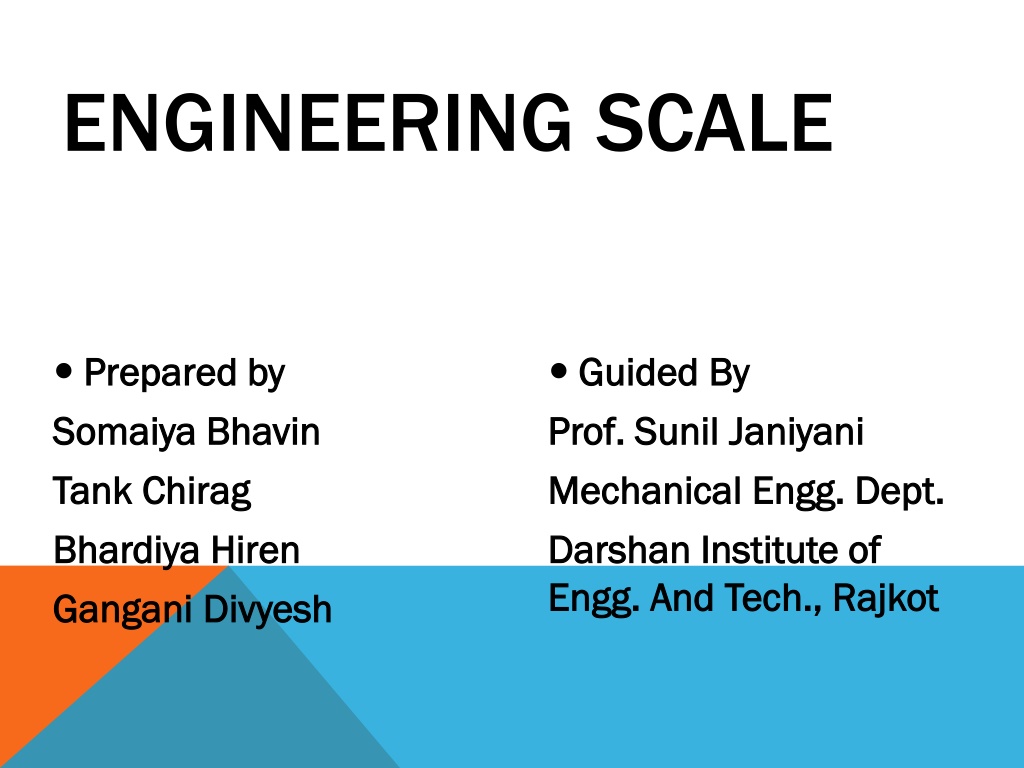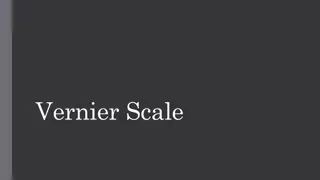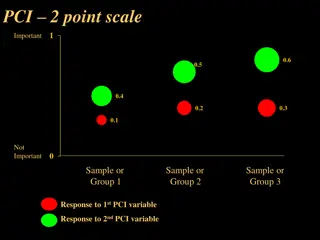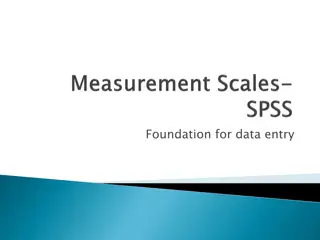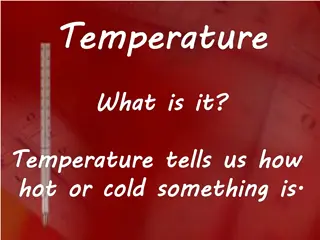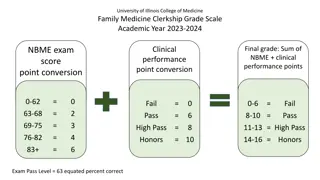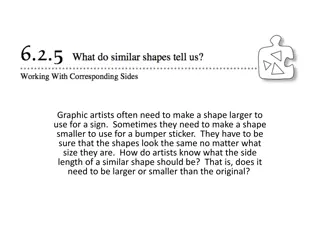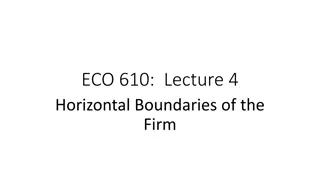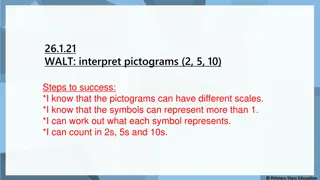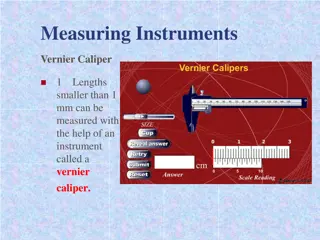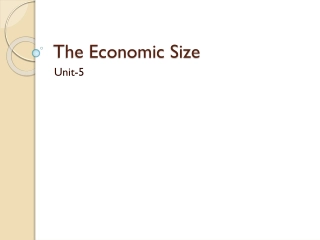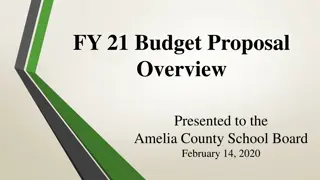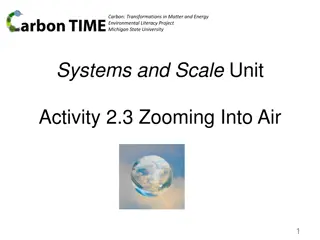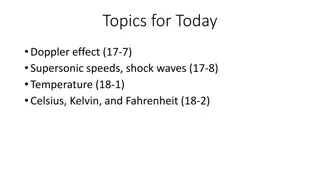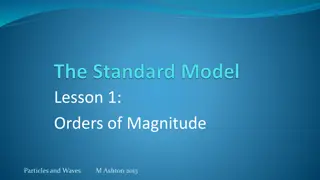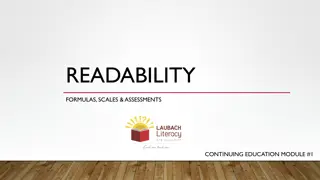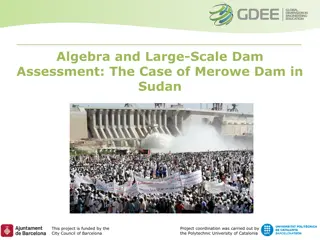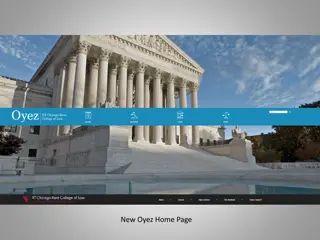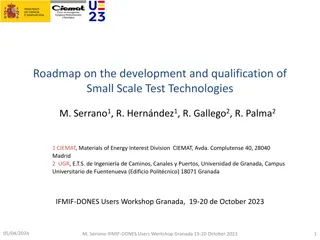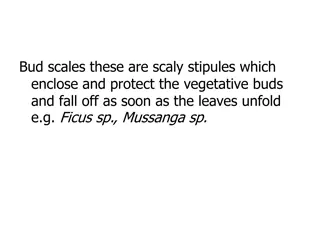Engineering Scale and Different Types of Scales
Engineering scale plays a crucial role in reducing or enlarging dimensions of large or tiny objects to fit standard size drawing sheets. This article covers the concept of reducing scale, representative factor, types of scales like plain, diagonal, vernier, and more, along with detailed construction methods for plain scales. It also provides information on different types of units and their conversions, helping in understanding and utilizing scales effectively.
Download Presentation

Please find below an Image/Link to download the presentation.
The content on the website is provided AS IS for your information and personal use only. It may not be sold, licensed, or shared on other websites without obtaining consent from the author. Download presentation by click this link. If you encounter any issues during the download, it is possible that the publisher has removed the file from their server.
E N D
Presentation Transcript
ENGINEERING SCALE Prepared by Prepared by Somaiya Somaiya Bhavin Tank Tank Chirag Chirag Bhardiya Bhardiya Hiren Gangani Gangani Divyesh Guided By Guided By Prof. Sunil Prof. Sunil Janiyani Mechanical Mechanical Engg Darshan Institute of Darshan Institute of Engg Engg. And Tech., Rajkot . And Tech., Rajkot Bhavin Janiyani Engg. Dept. . Dept. Hiren Divyesh
SCALES DIMENSIONS OF LARGE OBJECTS MUST BE REDUCED TO ACCOMMODATE ON STANDARD SIZE DRAWING SHEET.THIS REDUCTION CREATES A SCALE OF THAT REDUCTION RATIO, WHICH IS GENERALLY A FRACTION.. SUCH A SCALE IS CALLED REDUCING SCALE AND THAT RATIO IS CALLED REPRESENTATIVE FACTOR. FOR FULL SIZE SCALE R.F.=1 OR ( 1:1 ) MEANS DRAWING & OBJECT ARE OF SAME SIZE. Other RFs are described as 1:10, 1:100, 1:1000, 1:1,00,000 SIMILARLY IN CASE OF TINY OBJECTS DIMENSIONS MUST BE INCREASED FOR ABOVE PURPOSE. HENCE THIS SCALE IS CALLED ENLARGING SCALE. HERE THE RATIO CALLED REPRESENTATIVE FACTOR IS MORE THAN UNITY. USE FOLLOWING FORMULAS FOR THE CALCULATIONS IN THIS TOPIC. DIMENSION OF DRAWING DIMENSION OF OBJECT A REPRESENTATIVE FACTOR (R.F.) = LENGTH OF DRAWING ACTUAL LENGTH = AREA OF DRAWING ACTUAL AREA = V VOLUME AS PER DRWG. ACTUAL VOLUME = 3 V B LENGTH OF SCALE = R.F. MAX. LENGTH TO BE MEASURED. X
BE FRIENDLY WITH THESE UNITS. 1 KILOMETRE 1 HECTOMETRE 1 DECAMETRE 1 METRE 1 DECIMETRE 1 CENTIMETRE = 10 HECTOMETRES = 10 DECAMETRES = 10 METRES = 10 DECIMETRES = 10 CENTIMETRES = 10 MILIMETRES TYPES OF SCALES: 1. 2. 3. 4. 5. PLAIN SCALES ( FOR DIMENSIONS UP TO SINGLE DECIMAL) DIAGONAL SCALES ( FOR DIMENSIONS UP TO TWO DECIMALS) VERNIER SCALES ( FOR DIMENSIONS UP TO TWO DECIMALS) COMPARATIVE SCALES ( FOR COMPARING TWO DIFFERENT UNITS) SCALE OF CORDS ( FOR MEASURING/CONSTRUCTING ANGLES)
PLAIN SCALE:- This type of scale represents two units or a unit and its sub-division. PROBLEM NO.1:- Draw a scale 1 cm = 1m to read decimeters, to measure maximum distance of 6 m. Show on it a distance of 4 m and 6 dm. CONSTRUCTION:- a) Calculate R.F.= Length of scale = R.F. X max. distance = 1/100 X 600 cm = 6 cms b) Draw a line 6 cm long and divide it in 6 equal parts. Each part will represent larger division unit. c) Sub divide the first part which will represent second unit or fraction of first unit. d) Place ( 0 ) at the end of first unit. Number the units on right side of Zero and subdivisions on left-hand side of Zero. Take height of scale 5 to 10 mm for getting a look of scale. e) After construction of scale mention it s RF and name of scale as shown. f) Show the distance 4 m 6 dm on it as shown. DIMENSION OF DRAWING PLAIN SCALE DIMENSION OF OBJECT R.F.= 1cm/ 1m = 1/100 4 M 6 DM 10 1 0 4 3 2 5 METERS DECIMETERS R.F. = 1/100 PLANE SCALE SHOWING METERS AND DECIMETERS.
PROBLEM NO.2:- In a map a 36 km distance is shown by a line 45 cms long. Calculate the R.F. and construct a plain scale to read kilometers and hectometers, for max. 12 km. Show a distance of 8.3 km on it. CONSTRUCTION:- a) Calculate R.F. R.F.= 45 cm/ 36 km = 45/ 36 . 1000 . 100 = 1/ 80,000 Length of scale = R.F. max. distance = 1/ 80000 12 km = 15 cm b) Draw a line 15 cm long and divide it in 12 equal parts. Each part will represent larger division unit. c) Sub divide the first part which will represent second unit or fraction of first unit. d) Place ( 0 ) at the end of first unit. Number the units on right side of Zero and subdivisions on left-hand side of Zero. Take height of scale 5 to 10 mm for getting a look of scale. e) After construction of scale mention it s RF and name of scale as shown. f) Show the distance 8.3 km on it as shown. PLAIN SCALE 8KM 3HM 10 5 1 10 11 3 4 6 8 2 5 7 9 0 KILOMETERS HECTOMETERS R.F. = 1/80,000 PLANE SCALE SHOWING KILOMETERS AND HECTOMETERS
PROBLEM NO.3:- The distance between two stations is 210 km. A passenger train covers this distance in 7 hours. Construct a plain scale to measure time up to a single minute. RF is 1/200,000 Indicate the distance traveled by train in 29 minutes. CONSTRUCTION:- a) 210 km in 7 hours. Means speed of the train is 30 km per hour ( 60 minutes) PLAIN SCALE Length of scale = R.F. max. distance per hour = 1/ 2,00,000 30km = 15 cm b) 15 cm length will represent 30 km and 1 hour i.e. 60 minutes. Draw a line 15 cm long and divide it in 6 equal parts. Each part will represent 5 km and 10 minutes. c) Sub divide the first part in 10 equal parts,which will represent second unit or fraction of first unit. Each smaller part will represent distance traveled in one minute. d) Place ( 0 ) at the end of first unit. Number the units on right side of Zero and subdivisions on left-hand side of Zero. Take height of scale 5 to 10 mm for getting a proper look of scale. e) Show km on upper side and time in minutes on lower side of the scale as shown. After construction of scale mention it s RF and name of scale as shown. f) Show the distance traveled in 29 minutes, which is 14.5 km, on it as shown. DISTANCE TRAVELED IN 29 MINUTES. 14.5 KM 5 2.5 5 0 20 15 10 25 KM KM MIN 10 10 0 40 30 20 50 MINUTES R.F. = 1/100 PLANE SCALE SHOWING METERS AND DECIMETERS.
We have seen that the plain scales give only two dimensions, such as a unit and it s subunit or it s fraction. DIAGONAL SCALE The diagonal scales give us three successive dimensions that is a unit, a subunit and a subdivision of a subunit. The principle of construction of a diagonal scale is as follows. Let the XY in figure be a subunit. From Y draw a perpendicular YZ to a suitable height. Join XZ. Divide YZ in to 10 equal parts. Draw parallel lines to XY from all these divisions and number them as shown. From geometry we know that similar triangles have their like sides proportional. Y X 10 9 8 7 6 5 Consider two similar triangles XYZ and 7 7Z, we have 7Z / YZ = 7 7 / XY (each part being one unit) Means 7 7 = 7 / 10. x X Y = 0.7 XY :. Similarly 1 1 = 0.1 XY 2 2 = 0.2 XY Thus, it is very clear that, the sides of small triangles, which are parallel to divided lines, become progressively shorter in length by 0.1 XY. 4 3 2 1 Z The solved examples ON NEXT PAGES will make the principles of diagonal scales clear.
PROBLEM NO. 4 : The distance between Delhi and Agra is 200 km. In a railway map it is represented by a line 5 cm long. Find it s R.F. Draw a diagonal scale to show single km. And maximum 600 km. Indicate on it following distances. 1) 222 km 2) 336 km 3) 459 km 4) 569 km DIAGONAL SCALE SOLUTION STEPS: RF = 5 cm / 200 km = 1 / 40, 00, 000 Length of scale = 1 / 40, 00, 000 X 600 X 105 = 15 cm Draw a line 15 cm long. It will represent 600 km.Divide it in six equal parts.( each will represent 100 km.) Divide first division in ten equal parts.Each will represent 10 km.Draw a line upward from left end and mark 10 parts on it of any distance. Name those parts 0 to 10 as shown.Join 9th sub-division of horizontal scale with 10th division of the vertical divisions. Then draw parallel lines to this line from remaining sub divisions and complete diagonal scale. 569 km 459 km 336 km 222 km 10 9 8 7 6 5 4 3 2 1 0 KM 50 KM 100 100 0 400 300 200 500 KM R.F. = 1 / 40,00,000 DIAGONAL SCALE SHOWING KILOMETERS.
PROBLEM NO.5: A rectangular plot of land measuring 1.28 hectors is represented on a map by a similar rectangle of 8 sq. cm. Calculate RF of the scale. Draw a diagonal scale to read single meter. Show a distance of 438 m on it. DIAGONAL SCALE SOLUTION : 1 hector = 10, 000 sq. meters 1.28 hectors = 1.28 X 10, 000 sq. meters = 1.28 X 104 X 104 sq. cm 8 sq. cm area on map represents = 1.28 X 104 X 104 sq. cm on land 1 cm sq. on map represents = 1.28 X 10 4 X 104 / 8 sq cm on land 1 cm on map represent = 1.28 X 10 4 X 104 / 8 cm Draw a line 15 cm long. It will represent 600 m.Divide it in six equal parts. ( each will represent 100 m.) Divide first division in ten equal parts.Each will represent 10 m. Draw a line upward from left end and mark 10 parts on it of any distance. Name those parts 0 to 10 as shown.Join 9th sub-division of horizontal scale with 10th division of the vertical divisions. Then draw parallel lines to this line from remaining sub divisions and complete diagonal scale. = 4, 000 cm 1 cm on drawing represent 4, 000 cm, Means RF = 1 / 4000 Assuming length of scale 15 cm, it will represent 600 m. 438 meters 10 9 8 7 6 5 4 3 2 1 0 M 50 100 100 0 400 300 200 500 M M R.F. = 1 / 4000 DIAGONAL SCALE SHOWING METERS.
PROBLEM NO.6:. Draw a diagonal scale of R.F. 1: 2.5, showing centimeters and millimeters and long enough to measure up to 20 centimeters. DIAGONAL SCALE SOLUTION STEPS: R.F. = 1 / 2.5 Length of scale = 1 / 2.5 X 20 cm. = 8 cm. 1.Draw a line 8 cm long and divide it in to 4 equal parts. (Each part will represent a length of 5 cm.) 2.Divide the first part into 5 equal divisions. (Each will show 1 cm.) 3.At the left hand end of the line, draw a vertical line and on it step-off 10 equal divisions of any length. 4.Complete the scale as explained in previous problems. Show the distance 13.4 cm on it. 13 .4 CM 10 9 8 7 6 5 4 3 2 1 0 MM 5 4 3 2 1 5 0 15 10 CENTIMETRES CM R.F. = 1 / 2.5 DIAGONAL SCALE SHOWING CENTIMETERS.
